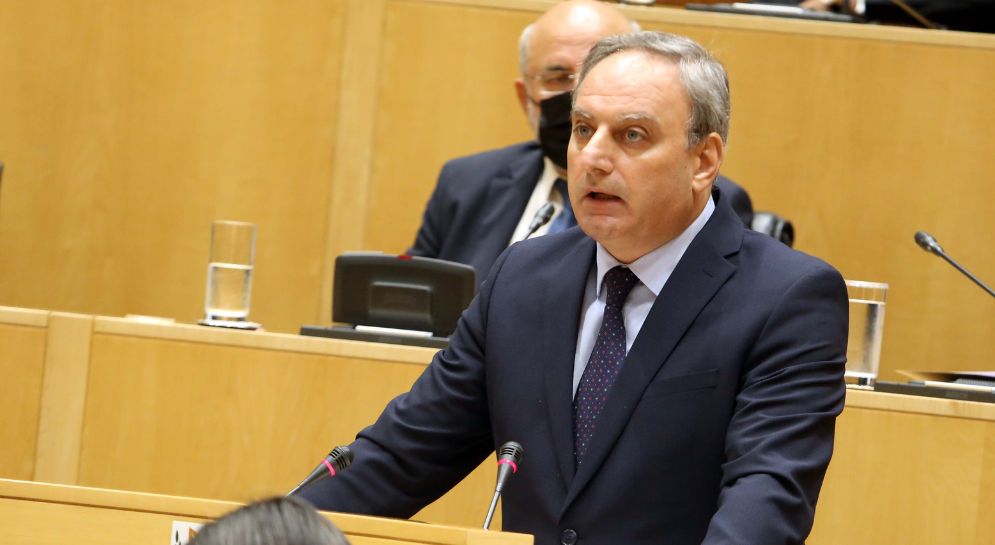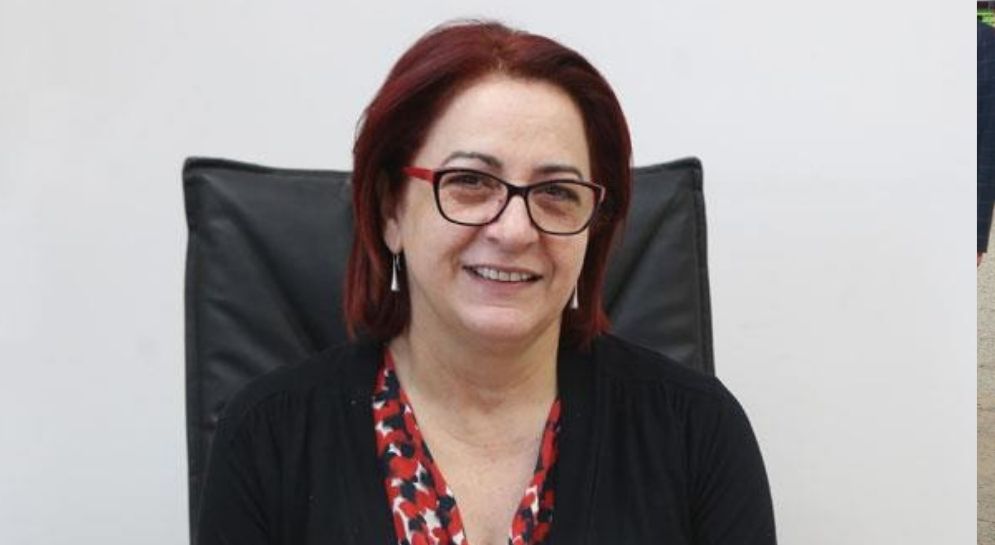The events of 25th March 1945 in the village of Lefkoniko
90th anniversary Communist Party of Cyprus – AKEL:
Article by Yiannakis Colocasides, Member of the Central Committee of AKEL
Sunday 27th March 2016, “HARAVGI” newspaper
The celebration of Greek National Independence Day on 25th March 1945 was marked by the bloody events that took place in the village of Lefkoniko. The colonial police without any provocation opened fire on a demonstration organized by the Organizations of the People’s Movement of the Left of Lefkoniko, killing the people’s fighters Andreas Exintaris and Andronikos Kyprianou, as well as a school pupil Mihalakis Kourtellas. Also injured from the police shootings were Loizos Yianni, Theodoros Avdrovikou, Anastasios Dimitriou, Kallinikos Symeou, Christodoulos Lagos, Ant. Georgallis, Kiriakos Siakallis, Chris. C. Mylonas, Sozos Siakallis, Antonis Meletiou, Pav. Karantivas, Yiakoumis Artemi and Georgios Symeou – all members of the Lefkoniko People’s Movement of the Left.
The events
AKEL, which was always paying tribute to Greek national Independence Day of 25th March 1821, invited the other political and social forces to organize all over Cyprus common celebrations, attaching an anti-colonial content to them. This move was in full compliance with AKEL’s long-standing position for the forging of a joint anti-colonial front of struggle. The appeal issued by AKEL found no resonance. Indeed, KEK [1]in a letter of its leader, the Mayor of Nicosia Themistoclis Dervis stressed that if the Nicosia School Board “were to even implicitly accept such a joint celebration (with AKEL) it would be worthy of hanging, abandoning our race’s noblest ideals in the eyes of school students”!!!
In Lefkoniko, however, a decision was taken to organize a joint celebration at the forefront of which would be the Lefkoniko High School. On the morning of 25th March the customary thanksgiving took place in the church of Sotiras, with the participation of all the organized groups of the village with their banners. In the churchyard Lefkoniko Higher School’s event was underway. When a representative of the People’s Movement of the Left made a request to address the event, a discussion ensued which was “completely calm”, as the “Independent” newspaper reported.
A march by the organizations of the People’s Movement of the Left subsequently took place to their local building. The march even passed by the building of the Tobacco Producers Association and the Religious Association, where the New Trade Unions (SEK) was also housed, where “it was welcomed by loud applause”, as the newspaper informs us. When the march reached near the building of the Organizations of the People’s Movement it came face to face with the police, who called on them to disperse and dissolve. The local leaders of the People’s Movement Organizations said they will dissolve, given that they would first enter their building and offices. Police officers without issuing any other warning and without any provocation, fired on the crowd, killing Andreas Exintaris and the school pupil Michalaki Kourtella. Many others were wounded, among them Andronikos Kyprianou, who died later in hospital from his injuries.
The British colonial government tried to justify the bloodshed by citing the official communiqué on the events that refers to “a fierce clash between opposing sides in Lefkonoiko on the morning of 25th March” and that “the police intervened to prevent a more serious clash between the two factions”.
However, the Municipality of Lefkoniko and the town’s organizations with a common statement of theirs gave a completely different picture of the events, refuting the official communiqué that was released. The joint statement issued by the Municipality and organized groups, having described the real events that took place, concludes that “in our opinion there was no threat whatsoever of a clash and confrontation. That’s precisely the truth about the events that unfolded. Any other report on the events constitutes a distortion of the truth or an attempt to justify this despicable action of the Police.”
Censorship
Immediately after the bloody events in Lefkoniko the British colonial government appealed to newspaper publishers and asked them not to publish anything until the inquiries of the investigative committee were completed. This committee was appointed to investigate the events. Newspaper publishers refused to do so, defending the freedom of the press and echoing the people’s sentiments. The colonial government reacted by imposing censorship on the press based on the Defence decree. On 27th March the “Independent” newspaper was published with a blank column in protest at the imposition of censorship. The next day, after a joint decision taken by the newspaper publishers, workers and newspaper sellers did not circulate any newspaper. In their joint statement, all the above “unanimously condemned the illiberal Press law, as well as the current legislation, which have abolished even people’s most elementary rights”.
It should be noted all Cypriot newspapers, including the Turkish Cypriot newspaper “Soz” and “Halkin Sesi”, also took part in this strike throughout the newspaper industry.
The People’s Movement of the Left
AKEL, the Pancyprian Trade Union Coordinating Committee and the Small shopkeepers Association sent telegrams in protest at the events of Lefkoniko, the recipients of which were the UK Prime Minister Winston Churchill, the ambassadors of the Soviet Union and the US in London, the British political parties, the Commonwealth Union, the British Trade Union Congress, British MP’s and English newspapers. The telegram, after making a brief reference to the events and expressing the indignation of the people of Cyprus, concludes with the following: “This bloody crime committed is the result of the repressive colonial laws, which allow the police to shoot against peaceful meetings of more than five people. The Cypriot people, who sent more than 20,000 of its children to the various war fronts to fight fascism, deserve the rapid implementation of the third article of the Atlantic Charter for Cyprus, which provides that all the Peoples should be left free to elect the Government of their choice.” It should be noted that that this telegram is one the first documents after the 1931 uprising, which makes a clear reference to the right to self-determination and to the demand for Enosis[2].
In Nicosia a massive all-Cyprus workers’ meeting was also organized with the participation of “thousands of workers.” Speeches were made and resolutions of protest were approved addressed to the Colonial Governor.
Everyone – except KEK
Another development was the joint communiqué issued by PEK[3], the Pancyprian Greek Socialist Vanguard[4] of Galatopoulos and AKEL. The three parties condemned the bloody events, considered that the police crime was the result of the illiberal laws and called for the “severe punishment of the policemen and the lifting of the existing illiberal laws.” They also stressed that the bloody events took place while the Cypriot people “was and is offering a huge service and making bloody sacrifices in the Allied struggle for freedom.”
As the “Independent” newspaper informs us, in the meeting between the three parties, which decided to issue the Joint Communiqué, the Cyprus National Party (KEK) of Dervis had also been invited. But KEK refused to participate and said that it will make its own separate representations because “there is a decision of the general meeting not to cooperate in any way with AKEL”!!!
Indication of the colonialist’s intentions
The bloodshed in Lefkoniko could not even remotely be justified by the alleged tense climate between the Left and Right. Differences and recriminations between the two spectrums did indeed exist. However, in the given period a climate of confrontation didn’t exist. On the contrary, the people enthusiastically followed the latest developments of the Second World War that were leading to the crushing of Hitler fascism. There were high hopes for the post-war world. The Allied forces were in general cooperating harmoniously and the Cold War had not yet broken out. The Church under Leontios[5] took a moderate stance that did not favour clashes and confrontations. The only anomaly was KEK and its anti-communist rage, which however at that time hadn’t yet found fertile ground. In Greece, three months had elapsed since the December events of the Civil War and the Varkiza Agrement (12th February 1945) had been signed. There was still the aspiration of a smooth progression of developments. Consequently, there wasn’t the climate of fierce confrontation between the Left and Right that would subsequently develop in the following years and reach a climax in 1948.
The colonial police citing the “the threat of a broader conflict” simply tried to justify the bloodshed. Besides, the finding of the investigation committee was never made public and that fact alone speaks for itself.
Were the bloody events in Lefkoniko on 25th March 1945 perhaps some isolated incident, which was due to some overzealous actions by the police? It would be naive for anyone to believe so. The events in Lefkoniko must be seen in relation to the trial and conviction of the Pancyprian Trade Union Committee PSE[6], the machinations and scheming to outlaw AKEL, the struggle for the demobilization of Cypriot volunteers and the murder of comrade Takis Kythreotou[7] and the exile of our “disobedient” soldiers to Egypt. The British colonial government’s behaviour in all these events wanted to give the message that it is determined to crush the anti-colonial struggle of the Cypriot people and the vanguard of this struggle, namely the Left. Therefore, the bloody events of Lefkoniko were no accident. It was the harbinger of the colonial violence to be unleashed and one of the first post-war incidents of the Cypriot people’s anti-colonial struggle.
Sources: “Independent” newspaper, the Electronic Archive of P. Papadimitriou
[1] KEK – Cypriot National Party, Right wing party founded in June 1943 whose influence rested on tradition and its conservative ideology. The Mayor of Nicosia, T. Dervis (later President of KEK), said that “they were forced to assume a decisive struggle against the internal enemy; AKEL and its scions”.
[2] Enosis: Union of Cyprus with Greece.
[3] PEK: established as the Pancyprian Farmers Union in 1942 as a counteraction to the rise of AKEL
[4] Traditional politician, formed his own party
[5] Elected Archbishop of Cyprus for only 36 days in 1947
[6] PSE: The unification of the class-based Trade Unions was achieved in November 1941, when a Trade Union Conference took place and the Pancyprian Trade Union Committee was subsequently formed and elected. In January 1946, the remaining Trade Union leaders of PSE, in replacement of the prohibited PSE that had been banned by the British colonialists, established the Pancyprian Federation of Labour (PEO).
[7] Takis Kithreotis: AKEL militant and sergeant who was killed in the struggle after the end of the Second World War for the demobilization of the thousands of anti-fascist Cypriot volunteers. Many were imprisoned in concentration camps in Cyprus and Egypt. The British colonialists were finally forced to demobilize the Cypriot volunteers.







